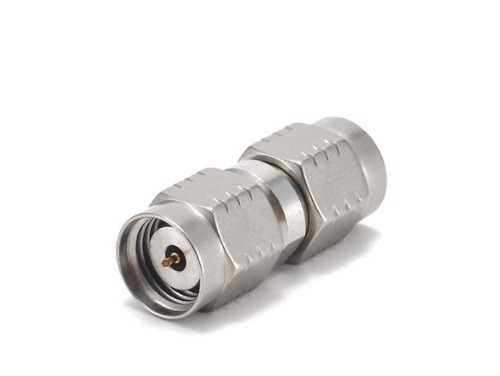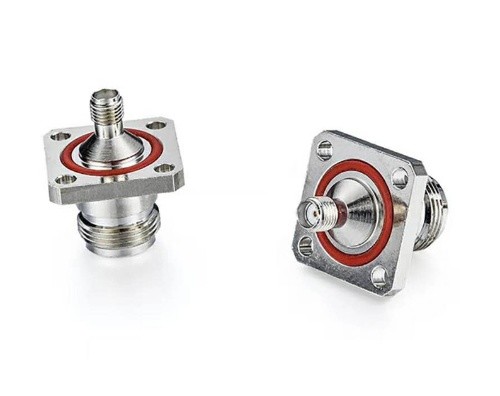HOW TO CHOOSE YOUR MICROWAVE CONNECTOR?
 Jul 01, 2021|
Jul 01, 2021| View:618
View:618In many RF and microwave applications, it is very important to choose the correct connector. The correct selection, use, and maintenance can extend the service life of the connector and optimize the performance of the system. Newcomers in the microwave field, often encounter different microwave connector selection problems.
People often ask: Can the standard SMA be connected with the standard 2.92?
What type of connector is this special?
Today, let’s talk about common high-frequency microwave connectors. Here, we will find the answer you want.

Why are there different connectors?
Many coaxial connectors are used in the RF and microwave fields, and each connector design has a special purpose and application. One of the key points is to be able to ensure the best performance and a maximum number of repeated connections.
First, introduce several common microwave connectors
N-type connector
The N-type connector was designed for naval systems in the 1840s (named source: Navy) and worked within 5 GHz. In the 1960s, the improved performance could reach 12GHz and later developed to 18GHz.
BNC connector
The BNC connector was originally designed for military applications (known as Bayonet Navy Connector). It uses a bayonet connection method, which provides fast connection and reliable contact. The working frequency can reach 4GHz, and it is widely used in radio equipment, electronic equipment, network system interconnection, and military applications.
TNC connector
TNC connector is a threaded BNC because it effectively solves the problem of BNC connector signal leakage and joint stability, the working frequency can reach 12GHz, and it is widely used in mobile phone microwave/antenna connection.
SMA connector
The SMA connector (Sub-Miniature-type A connector) was developed in the 1860s and was designed by Bendix Scintilla and Omni-Spectra. It was designed for the low-frequency connection of semi-rigid cables and devices. The standard SMA connector is designed to work at 12.4GHz, and the better SMA can be used at 18GHz or even 24GHz. The special high-quality SMA connectors produced by some manufacturers can reach 26.5GHz. SMA connectors have become one of the most commonly used connectors in the RF and microwave fields. However, due to its structural design, the service life is only a few hundred times, which is suitable for occasions with infrequent links.
SMB connector
The SMB connector (Sub-Miniature B connector) is a bayonet-type connector with a working frequency of 4GHz.
GPO (SMP) connector
The working bandwidth of the GPO connector is up to 40GHz. Based on the difference in the stop structure, the mating life varies from 100 to 1000 times.
GPPO (SSMP) connector
The GPO connector is only 1/3 of the GPO connector, and the working bandwidth is up to 65GHz.
Speaking of this, let's talk about the compatibility of precision SMA connectors. In order to reduce the reflection coefficient and improve the connection performance, a variety of "precision SMA connectors" have been developed. There are currently two basic structures (not real SMA connectors), one is 3.5mm (Wiltron WSMA) and the other is 2.92mm (Wiltron K).
You may have questions. When SMA and 3.5mm and 2.92mm connectors are connected to each other, there may be problems? What's the problem?
That is, when the male SMA connector is inserted into the 3.5mm or 2.92mm female connector, it may cause damage to the female connector.
In fact, as long as the operation specifications, the precision of the 3.5mm and 2.92mm connectors can ensure the safety of the connectors. However, the precision of the SMA male connector is relatively poor, especially if the SMA male connector is not properly aligned or straightened when it is connected, or the pin of the SMA male connector is too long, it will seriously damage the 3.5mm or 2.92mm female connector. This is especially important to note.
special reminder:
When using cables with SMA male connectors, especially semi-rigid cables, if they are bent near the connector, the length of the needle in the SMA male connector will change, even if a "connection protector" (ie. Adapter), will also push the pins in the connector, resulting in damage to the 3.5mm or 2.92mm female connector interconnected with this cable connector.
3.5mm connector
The 3.5mm connector was first developed by Hewlett Packard (HP Company, now Agilent) in the United States. The size and specifications are consistent with SMA. The difference is that the air medium is used in the connector and the working frequency is up to 34GHz. The physical interface is more sturdy and durable than SMA, which can realize thousands of repeated connections. Because the inner diameter of the outer conductor is 3.5mm, it is named the 3.5mm connector.
"K" and 2.92mm connectors
The "K" connector was developed and designed by Wiltron (now Anritsu) in 1983 and was named K (the K-band of the microwave band whose working frequency covers the microwave band). Because the inner diameter of the outer conductor is 2.92mm, it is called a 2.92mm Connector. The K connector can be connected to SMA, 3.5mm, and other 2.92mm connectors (such as HP 2.92mm). The operating frequency is 40GHz and it can be used up to 46GHz. Some manufacturers also call this connector 2.9 or SMK connector.
About 2.4mm and 1.85 mm connector structure
The 2.4mm and 1.85mm structural dimensions are designed to exceed the operating frequency limit of the SMA interface and are not mechanically compatible with the SMA interface. The most intuitive difference between this connector and the SMA series connector is that the gap between the center conductor and the outer conductor is smaller. However, for 2.92mm and 2.4mm connectors, if they are not compared together, it will be a little difficult to distinguish between the two. However, due to the incompatibility of the mechanical structure of these two types of connectors (the size and spacing of the threads are different), you can try to use a standard SMA Female or Male connector to interconnect with an unknown connector to determine whether the unknown connector is SMA compatible The connector or 2.4/1.85 connector.
2.4mm connector
The 2.4mm connector was jointly developed and designed by HP, Amphenol, and M/ACOM in the 1880s and used in 50GHz applications (because its working band covers the Q band of microwaves, it is also called a Q connector). The 2.4mm connector eliminates the vulnerability of SMA and 2.92mm connectors by increasing the thickness of the outer wall and strengthening the socket. Because the inner diameter of its outer conductor is 2.4mm, it is called a 2.4mm connector. Based on different application scenarios, 2.4mm connectors are divided into three quality levels, namely general level (low price, low repeatability, limited life, used in components and cables), instrument level (good repeatability, long life, Used in measurement), and measurement level (high performance, high repeatability, suitable for calibration).
1.85mm connector
The 1.85mm connector was developed and designed by HP in the 1880s, with a working frequency of 65GHz. In 1988, its standard was published to promote the standardization of this type of connector. The inner diameter of the outer conductor of this connector is 1.85mm, which can be directly mechanically interconnected with 2.4mm connectors, but cannot be directly mechanically interconnected with SMA series connectors.
V connector
The V connector is another connector designed and developed by Wiltron/Anritsu in 1989. It uses HP's 1.85mm structural standard and can be directly interconnected with 2.4mm connectors.
About 1.0 mm connector structure
The engineering of the modern millimeter wave industry and the need for test instruments have pushed its test bandwidth to the W-band (70~110GHz), and it is required that there is no need to switch to the waveguide. The appearance of a 1.0mm connector structure meets this demand. The inner diameter of the outer conductor is very small, only 1.0mm.
1.0mm connector
The 1.0mm connector was born in the late 1880s and was developed and designed by HP (Agilent) with a working bandwidth of 110GHz. Technicians and engineers in the laboratory have begun to apply 1.0mm connectors to millimeter-wave analysis. This type of connector is also often used in semiconductor probe platforms for evaluating millimeter-wave RF MMICs. The use of a 1.0mm coaxial connector greatly simplifies the multi-step waveguide-based test into one step. The name is the same as above because the outer conductor size is 1.0mm, it is called a 1.0mm connector.

W connector
The W connector was developed and designed by Wiltron/Anritsu in 1996, with a working bandwidth of 110GHz. Its characteristics and applications are the same as HP's 1.0mmm connector.
The connector precautions are summarized as follows:
1. Many coaxial connectors are designed with the accuracy and robustness of their mechanical interfaces in mind, but in use, frequent cleaning is very necessary, and the amount of torque added to the nut during tightening should also be appropriate , In order to ensure that the interval between the shoulder of the male contact and the female contact finger is the smallest. Only in this way can a good signal connection characteristic be guaranteed.
2. When using the SMA male connector to interconnect the precision SMA male connector (3.5mm or 2.92mm) of the female connector, the professionalism of the SMA male connector manufacturer must be guaranteed, and the connection must be guaranteed The male connector is connected in a straight and straight direction.
3. When using SMA cables, especially semi-rigid cables, please do not bend near the connector to prevent the inner center of the cable from causing length changes and damaging the female connector connected to it.
4. The 1.0mm female connector cannot be interconnected with the W male connector.
Tips:
It is also very important to check and clean the connectors regularly!
Inspection and cleaning steps:
1. Use a 20X magnification microscope to check the microwave connector;
2. If cleaning is required, please ensure that all equipment and operators are grounded;
3. Please avoid the use of mechanically damaged connectors (the connection surface is scratched, the center conductor is abnormal or bent);
4. Please use cotton swabs and absolute alcohol for cleaning. Excessive force or alcohol injection into the insulator when cleaning the center conductor will damage it;
5. All alcohol and dust particles must be blown clean with compressed air and sprayed vertically to prevent residues from being left on the joints.
EZCON telecom abundant experience in supplying RF connectors and cable assemblies. We are very confident that you can rely on us as a capable vendor.




 CopyRight © 2024 - EZCON Telecom Technology (changzhou) Co., Ltd.All rights reserved
CopyRight © 2024 - EZCON Telecom Technology (changzhou) Co., Ltd.All rights reserved





View More(Total0)Comment lists